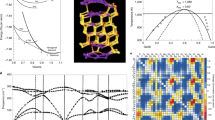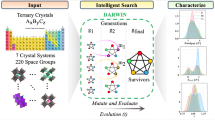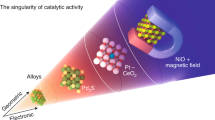Abstract
Our society’s environmental and economic progress depends on the development of high-performance materials such as lightweight alloys, high-energy-density battery materials, recyclable motor vehicle and building components, and energy-efficient lighting. Meeting these needs requires us to understand the central role of crystal structure in a material’s properties. Despite more than 50 years of progress in first-principles calculations, it is still impossible in most materials to infer ground-state properties purely from a knowledge of their atomic components—a situation described as ‘scandalous’ in the well-known essay by Maddox1. Many methods attempt to predict crystal structures and compound stability, but here I take a different tack—to infer the existence of structures on the basis of combinatorics and geometric simplicity2. The method identifies ‘least random’ structures, for which the energy is an extremum (maximum or minimum). Although the key to the generic nature of the approach is energy minimization, the extrema are found in a chemistry-independent way.
This is a preview of subscription content, access via your institution
Access options
Subscribe to this journal
Receive 12 print issues and online access
$259.00 per year
only $21.58 per issue
Buy this article
- Purchase on Springer Link
- Instant access to full article PDF
Prices may be subject to local taxes which are calculated during checkout





Similar content being viewed by others
References
Maddox, J. Crystals from first principles. Nature 335, 201 (1988).
Chaikin, P. Random thoughts. Phys. Today 8–9 (June 2007).
Hume-Rothery, W. Researches on the nature, properties, and condition of formation of intermetallic compounds. J. Inst. Met. 35, 319–325 (1926).
Hume-Rothery, W. Phase Stability in Metals and Alloys 3–23 (McGraw Hill, New York, 1967).
Miedema, A. R., de Boer, F. R. & de Chatel, P. F. Empirical description of the role of electronegativity in alloy formation. J. Phys. F 3, 1558–1576 (1973).
Pettifor, D. G. The structures of binary compounds. I. Phenomenological structure maps. J. Phys. C 19, 285–313 (1986).
Curtarolo, S., Morgan, D. & Ceder, G. Accuracy of ab initio methods in predicting the crystal structures of metals: review of 80 binary alloys. Calphad 29, 163 (2005).
Fischer, C. C., Tibbetts, K. J., Morgan, D. & Ceder, G. Predicting crystal structures by merging data mining with quantum mechanics. Nature Mater. 5, 641–646 (2006).
Sanchez, J. M., Ducastelle, F. & Gratias, D. Generalized cluster description of multicomponent systems. Physica A 128, 334–350 (1984).
de Fontaine, D. Cluster approach to order-disorder transformations in alloys. Solid State Phys. 47, 33–176 (1994).
Zunger, A. in Statics and Dynamics of Alloy Phase Transitions (eds Turchi, P. E. A. & Gonis, A.) 361–419 (NATO ASI Series, Ser. B, Plenum, New York, 1994).
Soven, P. Coherent-potential model of substitutional disordered alloys. Phys. Rev. 156, 809–813 (1967).
Gonis, A. et al. Configurational energies and effective cluster interactions in substitutionally disordered binary alloys. Phys. Rev. B 36, 4630–4646 (1987).
Pettifor, D. G. New many-body potential for the bond order. Phys. Rev. Lett. 63, 2480–2483 (1989).
Daw, M. S. & Baskes, M. I. Semiempirical, quantum mechanical calculation of hydrogen embrittlement in metals. Phys. Rev. Lett. 50, 1285–1288 (1983).
Daw, M. S. & Baskes, M. I. Embedded-atom method: Derivation and application to impurities, surfaces, and other defects in metals. Phys. Rev. B 29, 6443–6453 (1984).
Sluiter, M. H. F. Some observed bcc, fcc, and hcp superstructures. Phase Transit. 80, 299–309 (2007).
Santoro, A. & Mighell, A. D. Properties of crystal lattices: The derivative lattices and their determination. Acta Crystallogr. A 28, 284–287 (1972).
Santoro, A. & Mighell, A. D. Coincidence-site lattices. Acta Crystallogr. A 29, 169–175 (1973).
Hart, G. L. W. A new intermetallic prototype? Verifying new structure predictions in CdPt and PtPd, in Bulletin of the March Meeting (American Physical Society, 2007, http://meetings.aps.org/link/BAPS.2007.MAR.W23.11).
Pietrokowsky, P. Novel ordered phase, Pt8Ti. Nature 206, 291 (1965).
Ducastelle, F. Order and Phase Stability in Alloys (Cohesion and Structure, Vol. 3, North-Holland, Amsterdam, 1991).
Garbulsky, G. D., Tepesch, P. D. & Ceder, G. in Materials Theory and Modeling (eds Broughton, J., Bristowe, P. & Newsam, J.) 259–265 (Materials Research Society, Pittsburg, 1993).
Kanamori, J. & Kakehashi, Y. Conditions for the existence of ordered structure in binary alloy systems. J. Physique 38, 274 (1977).
Allen, S. M. & Cahn, J. W. Ground state structures in ordered binary alloys with second neighbor interactions. Acta Metallurg. 20, 423–433 (1972).
Sanchez, J. M. & de Fontaine, D. in Structure and Bonding in Crystals Vol. II (eds O’Keeffe, M. & Navrotsky, A.) 117–132 (Academic, New York, 1981).
Drautz, R. Ab-initio Statistical Mechanics for Ordering and Segregation at the (110) Surface of Ni90%-Al. Thesis, Max-Plank-Institut für Metallforshung (2003).
Acknowledgements
The author gratefully acknowledges financial support from the National Science Foundation through Grant Nos. DMR-0244183 and DMR-0650406. I would like to thank the following individuals for fruitful discussions: R. Drautz, S. Bärthlein, S. Müller, M. Leone and B. Kolb. Input from V. Blum was particularly useful.
Author information
Authors and Affiliations
Corresponding author
Rights and permissions
About this article
Cite this article
Hart, G. Where are nature’s missing structures?. Nature Mater 6, 941–945 (2007). https://doi.org/10.1038/nmat2057
Received:
Accepted:
Published:
Issue Date:
DOI: https://doi.org/10.1038/nmat2057
This article is cited by
-
Atomic-scale probing of short-range order and its impact on electrochemical properties in cation-disordered oxide cathodes
Nature Communications (2023)
-
Role of the M point phonons for the dynamical stability of B2 compounds
Scientific Reports (2022)
-
Bioinspired structural materials
Nature Materials (2015)
-
Influence of Microstructure on the Mechanical Properties of Ground State Structures in Substitutional Ordered Alloys
Metallography, Microstructure, and Analysis (2014)
-
A canonical stability–elasticity relationship verified for one million face-centred-cubic structures
Nature (2012)



